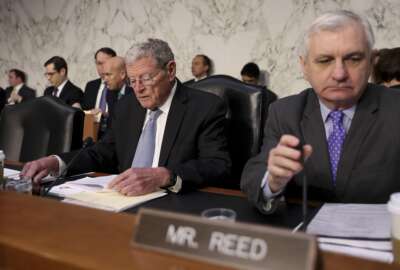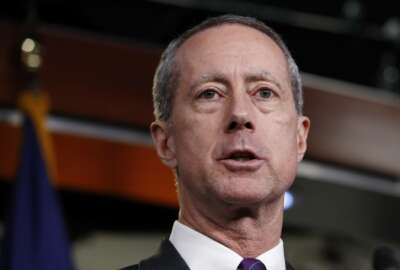
‘Fourth estate’ agencies safe from cuts for now as Congress rolls out its final version of the 2019 NDAA
Congress holds off on cutting agencies from DoD's fourth estate.
The Defense Department’s extra appendages aren’t being lopped off by Congress just yet.
The House and Senate agreed to a singular version of the 2019 defense authorization bill Monday and the proposed legislation keeps the Pentagon’s “fourth estate” intact.
The fourth estate refers to 28 agencies that are not part of a military service and employs 200,000 civilian personnel and nearly 600,000 contractors.
According to senior Armed Services Committee staff members, the bill does not get rid of the Washington Headquarters Services (WHS), the organization in charge of providing services to the Pentagon, DoD agencies and the National Capital Region.
That doesn’t mean that employees in the fourth estate can breathe a sigh of relief.
The bill “empowers the chief management officer to look at the back office function of all of those [agencies] and by 2020 submit a report on how on aggregate [the fourth estate] can get to a 25 percent reduction,” one senior staff member said.
The bill does not specifically eliminate any agencies.
That language — much more watered down than the original proposal — floated in April. That proposal would completely eliminate the Defense Information Systems Agency as well as the Defense Human Resources Activity, Defense Technical Information Center, Office of Economic Adjustment, Test Resource Management Center, Defense Technology Security Administration and WHS.
The House version of the bill then dialed back that plan a few weeks later stating it would only kill off WHS.
“Based on the reviews that we’ve done, based on when WHS was established you’re basically talking about the bureaucracy for the bureaucracy,” a House Armed Services Committee aide said.
The staffer added WHS was created to concentrate personnel functions; however, that mission is now diluted.
“The Army still maintains its personnelists, they nominate [a senior executive service (SES) member], the run the SES through the Washington Headquarters Service, they run that through the Office of Personnel Management. Is that middleman adding any capability? Or is it, in fact, simply reducing the efficiency and the speed in which the department can bring on a senior executive to help manage, for example, helping to recover technological superiority on hypersonics,” the staffer said.
Personnel Reform
Service members will see the biggest reforms to the military’s personnel system in decades.
The House and Senate agreed to an overhaul of the Defense Officer Management Personnel Act, which dictates how officers are promoted in the military.
The bill gives services the ability to change the promotion timeline for certain occupations.
This is something the Air Force is particularly interested in for pilots. As the service is struggling to keep pilots in the service, it found many pilots are not interested in the up-or-out system. They would rather just fly and not worry about meeting goals to become a general one day.
The bill expands officer spot promotions up to the colonel level. This would allow the service to give a lower ranking officer a higher rank on-the-spot if he or she takes a high demand or challenging job.
Finally, the bill repeals age restrictions on how old someone must be to reach a certain rank.
A senior committee aide said the services would have the option to use the new authorities at their discretion.
A Senate Armed Services Committee aide said many of the reforms in the bill are issues DoD wanted to address.
DoD and Congress already made some changes to DOPMA in order to retain talent and to recruit people in needed areas.
DoD already implemented a direct commissioning program for cyber professionals and the House version of the bill expands that authority to other occupations.
In the past DoD suggested allowing officers to opt-out of promotion board consideration upon request if it is deemed beneficial to the military. The Senate bill would most likely let the services use an authority similar to that.
The idea is something brought up in the past by former Defense Secretary Ash Carter as part of the Force of the Future initiative, which expanded maternity leave for service members and lengthened child care hours, among other things.
“In an effort to import talent development and management within the department, this proposal will ensure that officers, with the approval of the secretary concerned, are given the flexibility to explore educational and other career broadening opportunities, without being penalized for not meeting the promotion eligibility criteria in the usual time allotted,” the proposal stated.
Former Army Secretary and Force of the Future architect Brad Carson praised Mattis’ decision to rehash the promotion board issue.
“The proposed reforms are ones we did recommend as part of the Force of the Future and we thought were very common sense, but were somewhat controversial and it’s great to see DoD coming around to support them,” Carson said.
The “up or out” mentality hasn’t always worked to the benefit of talented officers. Officers who take unusual career paths or pursue experiences tend to be forced out of the military, despite being exactly the kind of innovative thinkers the 21st century military is trying to recruit.
Promotion boards, at times, will end up picking someone with operation experience in Iraq over a Rhodes Scholar. That ends up going counter to DoD’s policy decisions to prepare for future conflicts in new domains against more sophisticated adversaries.
Copyright © 2024 Federal News Network. All rights reserved. This website is not intended for users located within the European Economic Area.
Scott Maucione is a defense reporter for Federal News Network and reports on human capital, workforce and the Defense Department at-large.
Follow @smaucioneWFED
Related Stories






